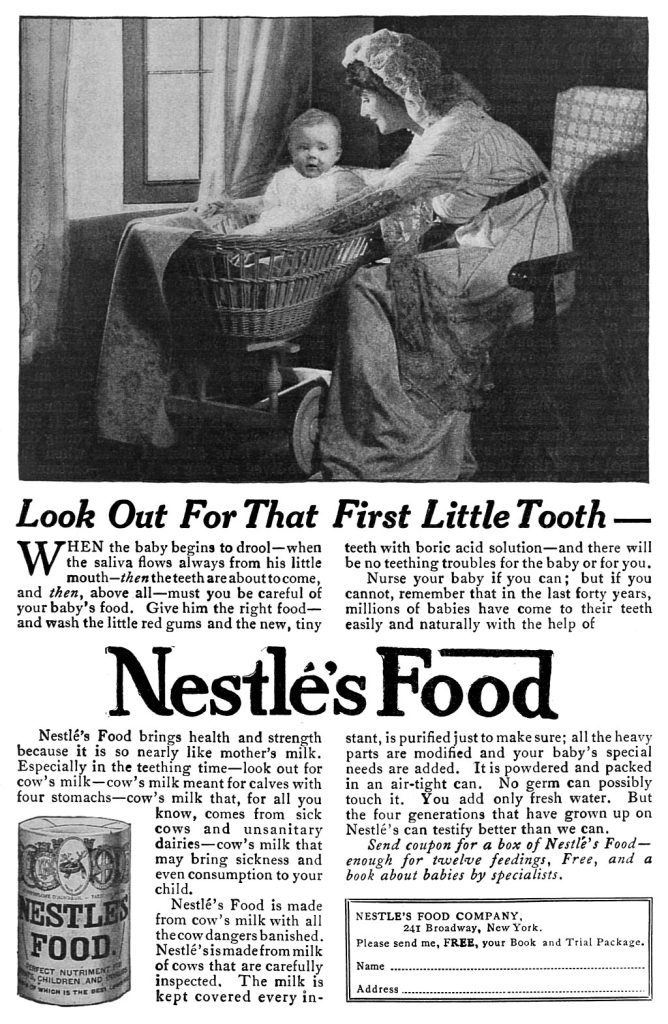
By Nestlé – Motion Picture Magazine (Aug 1915-Jan 1916), Public Domain, https://commons.wikimedia.org/w/index.php?curid=28559432
The Beginning: A Lifesaving Formula by Lake Geneva
In the rainy 1860s along Lake Geneva in Vevey, Switzerland, pharmacist and inventor Henri Nestlé paused over his modest workbench of glass jars and grains. A mother rushed in, cradling a frail infant unable to nurse.
Henri reached for a new blend—condensed milk, wheat flour, and sugar, carefully processed into a dry formula he named Farine Lactée. He handed it over gently:
“Add water, boil slowly. Perhaps… this will help.”
Days later, the infant’s cries filled the house again—a sound of life. That single success spread quickly. Nestlé stamped his boxes with a bird’s nest logo—“Nestlé” meaning “little nest” in German. Soon, the product crossed borders, carrying both nutrition and brand symbolism. By 1875, Henri sold his company—name and logo included—understanding that brands could matter as much as inventions.
Rivalry and Merger: The Anglo-Swiss Era
As steamships and railways expanded cities, demand for preserved milk surged. In 1866, American brothers George and Charles Page founded the Anglo-Swiss Condensed Milk Company, whose Milkmaid cans became kitchen staples.
Nestlé’s infant cereal and Anglo-Swiss condensed milk competed fiercely—until 1905, when the rivals merged. Nestlé & Anglo-Swiss Milk Company combined two wings of the dairy industry, accelerating global reach.
Coffee Revolution: The Birth of Nescafé
The 1930s brought mountains of unsold coffee beans in Brazil. Nestlé chemist Max Morgenthaler experimented tirelessly to preserve aroma and flavor. In 1938, he succeeded: Nescafé was born.
During WWII, lightweight instant coffee became a soldier’s companion. After the war, it fueled recovery, turning coffee into a daily ritual worldwide.
Sweet Expansion: Chocolate Joins the Family
Chocolate roots stretched further back. In 1929, Nestlé acquired Peter-Cailler-Kohler, a pioneer in milk chocolate. Storefronts soon displayed creamy chocolate bars with Nestlé’s name. The combination of dairy expertise and chocolate sweetness fueled global growth and a powerful new category.
The Flavor of Kitchens: Maggi and Instant Foods
By 1947, kitchens were changing. Nestlé merged with the Maggi company, adding seasonings, soups, and instant meals. “Maggi’s kitchen science meets Nestlé’s distribution,” executives declared, predicting a new era of dining convenience—a prediction that proved true, though not without future controversy.
Ethical Dilemmas: Baby Formula Boycotts
The 1970s brought sharp criticism of infant formula marketing in developing regions lacking clean water. Boycotts spread across the US and Europe, leading to the 1981 WHO Code of Marketing for Breast-Milk Substitutes. Nestlé pledged compliance with national regulations, but the debate cemented global scrutiny of corporate ethics in nutrition.
Building a Water Empire
In 1992, Nestlé acquired Perrier, reshaping Europe’s bottled water landscape. Soon, San Pellegrino and Acqua Panna filled refrigerators worldwide. Yet questions followed: Who owns water? Facing drought controversies, Nestlé eventually sold most North American water brands in 2021 for $4.3 billion.
Beyond Humans: Petcare and Everyday Growth
In 2001, Nestlé rebranded its St. Louis operations as Nestlé Purina Petcare, recognizing pets as family. Pet food sales proved resilient, pairing naturally with the rise of capsule coffee and daily essentials.
Crises and Lessons in Trust
- 2008 Melamine Scandal: Trace melamine in Hong Kong milk raised alarms, despite Nestlé’s clearance by regulators. Consumers learned that trust was more fragile than profit.
- 2015 Maggi Noodles Ban (India): Alleged lead contamination halted sales. Months of retesting led to reinstatement, but the lesson remained: trust takes longer to rebuild than to lose.
A New Era: Nutrition, Coffee, and Health Science
In 2017, Ulf Mark Schneider became the first outsider CEO since the 1920s. He redirected capital toward high-growth areas: coffee, pet care, nutrition, and health science.
- Coffee: Nestlé acquired Blue Bottle Coffee and secured a $7.15B global distribution deal with Starbucks.
- Health: Investments expanded into vitamins, supplements, and medical nutrition.
His vision: Nestlé as not just a food giant, but a company shaping how people eat, drink, and recover health.
Difficult Choices and Sustainability Questions
Nestlé sold parts of its water and confectionery divisions while keeping icons like KitKat (outside the US). Lawsuits over child labor in cocoa farms highlighted the deeper challenges of supply chains. Words like traceability and farmer income became pillars in Nestlé’s sustainability reports.
Post-Pandemic Adaptations: Vital Pursuit
With new diets shaped by GLP-1 weight-loss drugs, Nestlé launched Vital Pursuit in 2024—protein- and fiber-rich portioned meals designed for smaller appetites. A food company, once again, translated lifestyle shifts into everyday nutrition.
Today: The Global Table
From Vevey’s lakeshore to kitchens, cafes, and pet bowls around the globe, Nestlé has become a giant communal table. Coffee, chocolate, water, baby food, pet care, and supplements—all linked by choices about what to keep, what to let go, and how to balance resources with rights.
Henri Nestlé’s bird’s nest logo still carries its meaning: to feed, to nurture, to protect. But like a real nest, it is never truly full. The questions of sustainability, ethics, and health remain—waiting to be answered for the next generation.
